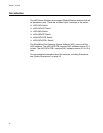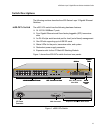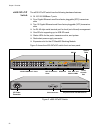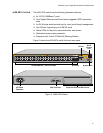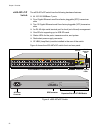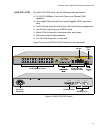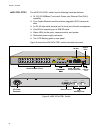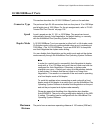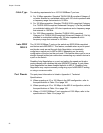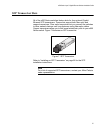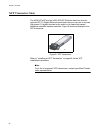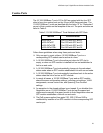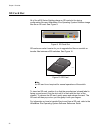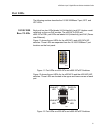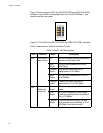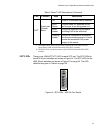Chapter 1: Overview
26
Cable Type The cabling requirements for a 10/100/1000Base-T port are:
For 10 Mbps operation: Standard TIA/EIA 568-B-compliant Category 3
or better shielded or unshielded cabling with 100 ohm impedance and
a frequency range that extends to 16 MHz.
For 100 Mbps operation: Standard TIA/EIA 568-A-compliant Category
5 or TIA/EIA 568-B-compliant Enhanced Category 5 (Cat 5e) shielded
or unshielded cabling with 100 ohm impedance and a frequency range
that extends to 100 MHz.
For 1000 Mbps operation: Standard TIA/EIA 568-A-compliant
Category 5 or TIA/EIA 568-B-compliant Enhanced Category 5 (Cat 5e)
shielded or unshielded cabling with 100 ohm impedance and a
frequency range that extends to 100 MHz.
Auto-MDI/
MDI-X
The 10/100/1000Base-T ports on the switch are IEEE 802ab-compliant
and feature auto-MDI/MDI-X. This feature, available when a port’s speed
and duplex mode are set through Auto-Negotiation, automatically
configures a switch port to MDI or MDI-X depending on the wiring
configuration of the port on the end node. This feature allows you to use a
straight-through twisted pair cable when connecting any network device to
a port on the switch.
Disabling Auto-Negotiation on a port and setting the speed and duplex
mode manually also disables the auto-MDI/MDI-X feature. A port where
Auto-Negotiation has been disabled defaults to MDI-X. Disabling Auto-
Negotiation may require manually configuring a port’s MDI/MDI-X setting
or using a crossover cable.
Port Pinouts The port pinout information is listed in Appendix A, Technical
Specifications.
When operating at 10 or 100 Mbps in the MDI configuration, refer to
the specifications in Table 13 on page 106.
When operating at 10 or 100 Mbps in the MDI-X configuration, refer to
the specifications in Table 14 on page 106.
When a 10/100/1000Base-T port operates at 1000 Mbps, refer to the
specifications in Table 15 on page 107.



